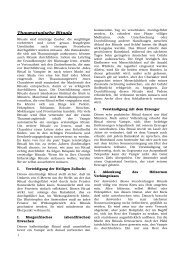CHAPTER 2 CHAPTER 3 CHAPTER 1 CHAPTER 2 CHAPTER 3 ...
CHAPTER 2 CHAPTER 3 CHAPTER 1 CHAPTER 2 CHAPTER 3 ...
CHAPTER 2 CHAPTER 3 CHAPTER 1 CHAPTER 2 CHAPTER 3 ...
Create successful ePaper yourself
Turn your PDF publications into a flip-book with our unique Google optimized e-Paper software.
<strong>CHAPTER</strong> 4 109<br />
flourishing in places where twenty years ago there were ice fields!<br />
Dr. George H. T. Kimble, director of the American Geographical Society, says it is altogether possible that<br />
Canadians in Northern Ontario will grow corn and New Yorkers will become cotton planters. He points out<br />
that temperatures have been rising in winter in the last thirty to forty years. In Upper Canada, he relates, the<br />
forest is migrating into hitherto barren tundra.<br />
Arnold Court of the University of California says we can expect temperatures over one-hundred seven degrees<br />
in the summers of the future. Scientists probing glaciers throughout the world, including the great Baffin<br />
Island glacier, have discovered these glaciers are steadily shrinking.<br />
Dr. John W. Aldrich, of the U. S. Fish and Wildlife Service, says that fish are moving northward. Cod, once<br />
unknown in Greenland, is now a steady Eskimo dish. Whiting, halibut, king mackerel and haddock are found<br />
farther and farther north in the Atlantic. New Jersey has sighted tropical flying fish! The tropical-fish hunting<br />
grounds of the future will be along the New Jersey and Maryland coasts instead of Florida and the Bahamas,<br />
as at present. For some years now, deep sea pleasure fisherman have been taking tuna off the Long Island<br />
Coast and even further to the North. It was not so long ago that tuna were seldom observed further North than<br />
Georgia waters.<br />
The tremendous warming-up is also observable north of the United States--Canada, Alaska, and Greenland.<br />
The size and extent of glaciers in all these areas have been decreasing at an unprecedented rate, exposing vast<br />
areas for potential cultivation. In Alaska, Muir Glacier has been shrinking in length at a rate of about half a<br />
mile a year, while Guyot Glacier has been losing thickness at about thirty feet a year. Alaskan farmers are<br />
now growing crops in areas that only a few years ago were snow-covered. Along the Alaskan Arctic Coast,<br />
much of the ground is bare of snow through many months each summer, while temperate-zone trees and<br />
shrubs are appearing further to the North and higher on the mountainsides. Alaskan forests are "advancing",<br />
according to authority Dr. Robert E. Griggs. Along the entire roof of the North American continent, the Arctic<br />
Ice is receding rapidly. It used to contact the coast solidly and be many feet thick in winter. Now there are<br />
often open patches of water extending fifty or more miles offshore, while the thickness of the ice has greatly<br />
decreased.<br />
Ships are now frequently able to put in at Greenland ports in mid-winter. Fresh land is steadily being bared by<br />
the receding icecaps, and vegetation and birds that formerly shunned Greenland are appearing. The great strait<br />
between Greenland and Canada that used to be ice-locked the year around is now frequently open to ships. In<br />
the United States the climate will be like that of present day Mexico. Canada's climate will resemble that of<br />
the United States today. Greenland's climate will resemble that of Canada now. However, if the trend does not<br />
slow down, the entire equatorial belt will become unfit for human habitation--the temperate zones will<br />
become largely scorching deserts, while only the polar regions will be comfortably habitable.<br />
In the United States, "dust bowl" areas are increasing. In Africa, the Sahara Desert is advancing Southward at<br />
a rate of three miles a year. The Middle East is steadily declining in water supply, while much of India and<br />
China, once fertile agricultural land, is now semi-desert or actual desert without vegetation of any sort. In<br />
Central Africa, the lakes are becoming smaller and the jungles less lush. This is also true of South America,<br />
where the Amazon River Basin and jungle areas are shrinking rapidly, with grasslands developing around the<br />
periphery. Lake Victoria in Africa is dropping at the rate of almost a foot a year while the amount of water<br />
flowing over Victoria Falls has declined greatly.<br />
Great Salt Lake in America has shrunk by half in less than fifty years, and the waterpower production of<br />
Niagara is declining. In one-hundred years the temperature of England has risen by three degrees. Similar<br />
rises have been noted in other countries where accurate weather records have been kept. It has been estimated<br />
that a rise in average temperature of only six degrees would melt all the glaciers and polar icecaps in the world<br />
in a few decades. The sea-level of all the oceans is rising at a rapid rate.






